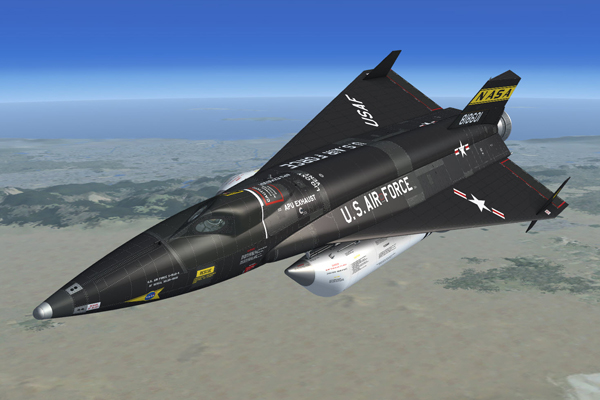
X-15AD-4.
Note: The X-15AD-4 is a fictitious delta wing X-15, based on different proposed configurations for future X-15 airplanes.
Engines
One (1) Reaction Motors XLR-99 "throttable" liquid-fuel turborocket engine |
60,000 lbs (thrust) |
Two (2) Thiokol "Castor 1" solid rocket boosters |
45,000 lbs (thrust X2) |
Aircraft Weight with Solid Rocket Boosters
Launch |
46,840 lbs |
Burnout (boosters jettisoned) |
16,500 lbs |
Landing (boosters jettisoned) |
15,600 lbs |
Aircraft Weight without Solid Rocket Boosters
Launch |
36,600 lbs |
Burnout |
19,200 lbs |
Landing |
17,500 lbs |
Speed Limitations
Note: The current maximum speed attainable in the simulator is approx. Mach 4.65.
MMO – Maximum Aircraft Operating Speed (Mach) |
4.65 Mach |
Maximum Speed with Boosters Attached (Mach) |
2.6 Mach |
VLO – Maximum Gear Operating Speed |
300 KIAS |
VLE – Maximum Landing Gear Extension Speed |
300 KIAS |
q – Maximum Dynamic Pressure without Boosters |
2200 psf |
q – Maximum Dynamic Pressure with Boosters |
1000 psf |
Maximum Acceleration (above 50,000 feet) |
8 G |
Mach Limitations vs Altitude
10,000 feet |
0.8 Mach |
20,000 feet |
1.6 Mach |
30,000 feet |
1.8 Mach |
40,000 feet |
2.8 Mach |
50,000 feet |
3.5 Mach |
60,000 feet |
4.0 Mach |
70,000 to 100,000 feet |
4.65 Mach |
Fictitious Ground Takeoff in the Simulator (standard temperature, sea level pressure altitude)
Note: The X-15AD-4 addon can take off from the ground, like any other aircraft in the simulator.
V1 – Aircraft Takeoff Decision Speed (51,600 lbs) |
250 KIAS |
VR – Aircraft Rotation Speed |
275 KIAS |
V2 – Aircraft Takeoff Safety Speed |
290 KIAS |
Launch from a Fictitious Carrier Aircraft in the Simulator
Note: It is possible to simulate a high altitude launch from a fictitious carrier aircraft by using the slew mode commands* to reposition the X-15AD-4 without flying in real time or by changing the altitude and speed settings in the map dialog box. A high altitude launch flight can also be loaded.
Recommended Launch Altitude |
38,000 to 45,000 feet |
Recommended Launch Speed |
0.75 to 0.82 Mach |
Solid Rocket Boosters Release
Note: Under normal flight conditions, solid rocket boosters should be released as soon as practical after they are burned out, at about 125,000 feet and Mach 2.8, in a zero-G normal load factor condition and an angle of attack of about 10 degrees.
The maximum Mach number to be reached by the X-15AD-4 with the solid rocket boosters attached is 2.8. The boosters must be released before reaching that speed. This limit is imposed because flight characteristics for this configuration have not been determined for higher Mach numbers.
Maximum Mach Number with Solid Rocket Boosters Attached |
3.0 Mach |
Recommended Mach Number for Solid Rocket Boosters Release |
2.5 to 3.0 Mach |
Recommended Altitude for Solid Rocket Boosters Release |
80,000 to 150,000 feet |
Maximum Angle of Attack with Solid Rocket Boosters Attached |
16 degrees |
Recommended Angle of Attack for Solid Rocket Boosters Release |
5 to 10 degrees |
Normal Load Factor Condition Recommended |
0-G |
Altitude Limitations (Typical)
Aircraft Operating Altitude |
45,000 to 200,000 feet |
Aircraft Ceiling (maximum) Altitude |
520,000 feet |
Other Limitations (Typical)
Maximum Allowable Rate of Roll |
100 degrees per second |
Speed Brakes
The speed brakes are not to be used at full deflection below Mach 1.5.
Note: The speed brakes on this airplane were not designed for use as a low-speed drag device. Their design function is to provide necessary drag conditions for control of the airplane at supersonic speeds and relatively high altitudes.
Prohibited Maneuvers
The real-world airplane was restricted from performing the following maneuvers:
1. Spin
2. Snap Rolls
3. Snap Maneuvers
Propellant Jettison
Note: While approaching the landing site, the remaining propellants must be jettisoned to minimize fire or explosion hazards and to lower the weight of the aircraft.
Maximum Speed at 30,000 feet |
0.60 Mach |
Maximum Speed at 15,000 feet |
0.45 Mach |
Dummy Ramjet Jettison
Note: Under normal flight conditions, the dummy ramjet should not be jettisoned except during landing approach. The ramjet must be jettisoned to provide ground clearance for the landing gear.
Maximum Mach Number |
300 KIAS or 3.5 Mach, whichever comes first |
Recommended Altitude |
5000 feet |
Minimum Altitude |
1500 feet |
Maximum Angle of Attack |
16 degrees |
Maximum Rate of Roll |
30 degrees per second |
Landing
High Key Point (106 seconds from landing) |
15,200 feet, 300 KIAS, gear and flaps up (45-degree bank turn) |
180-Turn (82 seconds) |
11900 feet, 270 KIAS, gear and flaps up |
Low Key Point (58 seconds) |
8700 feet, 240 KIAS, gear and flaps up (180 degrees opposite to the runway) |
90-Degree Point (36 seconds) |
5800 feet, 240 KIAS, gear and flaps up (90 degrees perpendicular to the runway) |
Ventral (or ramjet) Jettison |
5000 feet, 240 KIAS (lined up with the runway) |
Gear Down (10 seconds) |
2700 feet, 240 KIAS, 1.29 G pullout |
Flare Completed |
2200 feet, 174 KIAS |
Touchdown (0 seconds) |
174 KIAS |
VREF - Landing Approach Speed (flaps extended, gear down) |
174 KIAS |
Aircraft Stalling Speed |
100 KIAS |
Note: For explanations of speeds used on this tab, see "V-speeds" in the Learning Center Glossary (Flight Simulator X).
*: For instructions on how to use the slew commands to reposition the aircraft without flying in real time, see "Slewing" in the Learning Center Glossary (Flight Simulator X).
See also:
Aircraft Reference Information (X-15A-2)